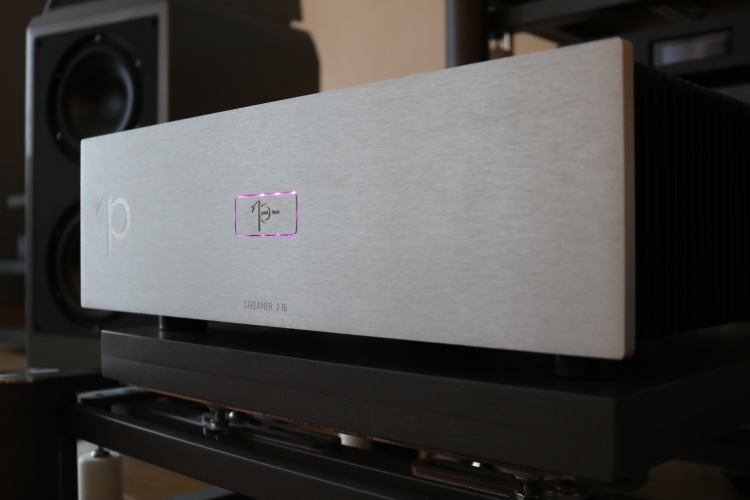
Technical details
The streamer 2.16 is available in two versions: the standard 2.16 and the 2.16 X and they use the same PSU and computer components. The difference between the two is that the 2.16 X has three low-noise OCXO clocks, all internal wiring upgraded to high-end, all rhodium fuses and a Furutech FI09-Rhodium-NCF AC-inlet.
Both streamers can be roughly classified into three categories:
- The linear PSU
- The computer components
- The software
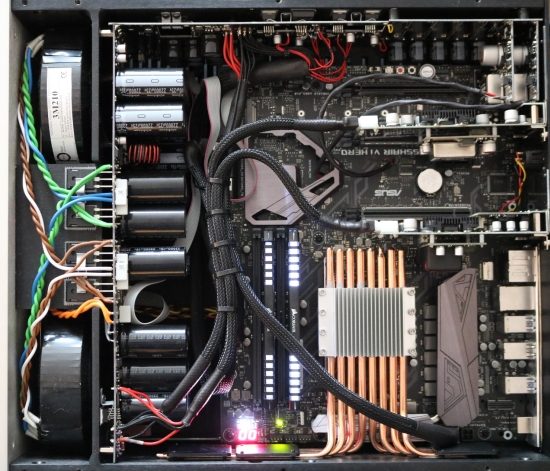
Linear Power Supply Unit
The linear PSU is designed in-house and contains three transformers providing four main power rails from which all separate voltages for each part of the streamer are regulated. Every part of the streamer has its own dedicated regulation from the corresponding power rail. It depends on the configuration of the streamer how many linear regulations are used. For example, the ATX to the motherboard contains 5 different voltage levels, all have their own linear regulation. Also, each SSD has its own linear regulation, the processor has its own, every OCXO clock has its own, etc. The maximum amount of linear regulations depends on the configuration of the server. The more SSD’s the more regulations, the more OCXO clocks the more regulations. The streamer 2.16 X (top model) can go up to 20 linear regulations.
The most-asked questions about the linear PSU of the Pink Faun streamer 2.16 are gathered in the following Q&A:
- A) Why do you use three smaller separated and not one big mains transformer? There are two reasons for this, first smaller transformers are more stable under high current swings and have less chance of humming during high current peaks. Secondly, and most importantly, each transformer is used for its dedicated area of operation. One for the processor, one for the motherboard and one for the peripherals. A streamer supply has a highly peaking current load and all currents add up in the transformer core and interact with each other. By separating the main areas of a streamer in each transformer interaction is less and will improve the final sound quality.
- B) Why do you use chokes in your power supplies? Due to its intrinsic properties, a capacitor buffered power supply does not draw a continuous, but a highly peaked current. Each 100Hz capacitor is filled up for the full cycle in only microseconds, depending on the duty cycle of the power supply. The higher the capacitance and the lower the inductance (and Rdc) of the transformer, the lower the duty cycle and the higher these peaks are. These peaks introduce large Hf-noise in power supplies. In Pink Faun power supplies we use high inductance power transformers (low field saturation in the core) and we use pi-filtering to keep the peaks at a minimum and thus Hf noise. The less rubbish in, the less we have to filter later.
- C) Why do you use separated power rails and not one single mains supply? All loads, in the end, come together in the source of power. In this source, they interact resulting in harmonics and intermodulation noise. The earlier all separated loads are split in the device, the less they interact, resulting in the lowest initial noise in power supplies. Also by using a lot of smaller separated and regulated supplies, we can keep current loops very minimal and local, which also will reduce the spread of EMC inside the device. This is why Pink Faun streamers use separated rails for dedicated areas and a separated regulator each for each load. Great care is taken in adding these power supplies all together in a single star-configured ground and also to source all ingoing voltage from star outputs in the power supply resulting in minimal interference and minimal Hf noise and harmonics.
- D) What can we do to get the lowest noise possible in the streamer power supply? Even the best regulators have very poor Hf characteristics. The noise of the regulator itself is a factor in the final supply’s output noise, but even more important is the noise of the mains power, EMC noise (from outside and the device itself) and noise generated by the rectifying and current peaks of the capacitors. All these noise sources have to be minimized in order to let the regulator get to its optimal performance. This means special low inductance transformers, Schottky diodes, low ESR capacitors and a lot of common and differential mode Hf filtering, separated rails, lots of regulators with localized current loops, star sources, and ground, shielded power planes on the PCBs, cable setup, etc. In the end, the final result is the addition of all efforts taken right from the mains input of the power supply to the connector of the motherboard.
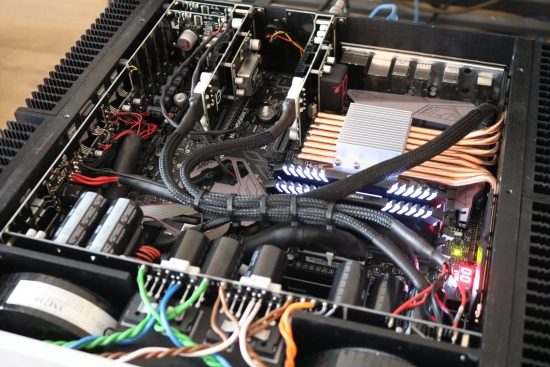
Computer Components
The computer components are chosen for their stability and good performance. The streamer 2.16 can easily handle all PCM streams and DSD up to DSD512. Because of the stable, powerful processor, the streamer 2.16 can be configured with the minimum buffer size in both ROON and HQPlayer. The processor is passively cooled using an 8-pipe cooling system and can handle the high DSD sampling easily. Playing normal Redbook audio the load on the processor is between 0 and 1 %, upsampling Redbook to DSD512x48 (HQPlayer / Poly-Sinc-XTR-2 filter) the load is between 12 and 16%. The streamer standard has a Samsung Pro SSD for the Linux OS and there’s room for two more SSD’s for music storage.
– For even better performance, the motherboard of the streamer 2.16 X is equipped with two OCXO clocks, the system clock (chipset) and the processor clock. The system clock (chipset) is needed to synchronize all components/clocks on the motherboard. This clock also synchronizes the clock for the CPU, but the CPU clock is only used on the chip (PROCESSOR) itself. Because the CPU needs to perform more operations per time than the motherboard the clock frequency will be multiplied in the CPU. The CPU clock runs on 25Mhz and is multiplied 136 times. Therefore the processor runs at a fixed frequency of 3,4 GHz. The advantage of using an OCXO clock on well-chosen key areas in the streamer 2.16 is not the better stability but the low phase noise. Both OCXO clocks on the streamers 2.16 motherboard have their own low-noise linear regulation, this results in a lower noise floor in the whole system which increases the listening experience dramatically.
Software
The used OS on the streamer 2.16 is a heavily modified version of Arch Linux (Low Latency / Real-time kernel / Headless). The advantage of using Linux is you start with nothing and only configure what you really need for audio playback. The Pink Faun streamer 2.16 can work standalone and is fully controllable from a tablet and/or smartphone. The streamer 2.16 runs in headless mode which means there’s no video driver loaded which results in an even lower noise floor in whole the system. The default playback software is Roonserver, for those who want to up-sample all music files to DSD (maximum DSD rate depends on the DAC) HQPlayer-embedded is installed as well and can be activated at all times. We have chosen for the Arch Linux OS for several reasons. One of the main reasons is HQPlayer-embedded is Linux only. Linux is a very stable and reliable OS that can be modified heavily. Also, and most important is, with Linux, we can reach an incredibly low latency (audio latency and processor latency). During the process of developing the streamer 2.16, we found out that latency is one of the key elements to get the really smooth and natural sound, the lower the latency the better. That’s why buffer-size is always turn off or chosen at the lowest option possible in the playback software. Because the latency is so low in the streamer 2.16 (Audio latency at 192 kHz < 2,67 ms on AMD Ryzen processor and high-quality digital audio interface. Audio latency at 44.1 kHz < 1 ms depending on hardware configuration. Incredibly low processor latency average 4-6 microseconds on AMD Ryzen processor ) we need a solid stable processor and therefore we have chosen the AMD Ryzen 8-core processor.
Technical Specifications
Streamer 2.16 X hardware
- Custom-made aluminum rigid frame.
- Fully passively cooled, no moving parts.
- Three Low-B, internal- and external shielded power transformers.
- Up to 20 linear regulated supplies (depending on hardware configuration).
- Separate linear supply for the processor, motherboard, SSD’s, OCXO clocks and the digital output
card. - Schottky rectifier diodes, crystalline core choke Pi-filters.
- Low ESR, 105-degree Nichicon capacitors, the total buffer capacity is more than 800.000uF.
- Star-grounding- and star-power supply design.
- Separate powered OCXO clock for the system clock.
- Separate powered OCXO clock for the processor.
- Separate powered OCXO clock for every digital output card.
- Hardware designed and hand-built in The Netherlands.
- Full-size ATX motherboard with optimized BIOS settings.
- 8-core processor, passively cooled with eight heat pipes cooling system, no moving parts inside.
- Low-latency DDR4 memory.
- Samsung Pro SSD for the operating system and playback software, additional music storage up to 8TB SSD.
Software
- Custom Arch Linux ultra-low latency real-time kernel operating system.
- Roon Core server.
- HQPlayer high-quality bit-perfect multichannel audio player (PCM en DSD).
- Tidal high-res streaming (Tidal subscription not included).
- Qobuz high-res streaming (Qobuz subscription not included).
- Extremely low processor- and audio Latency.
- Including professional remote support.
Try out Roon for yourself
Videos on the Hifi-Advice YouTube Channel
How Sooloos became Roon
HFA Front Page
External Links
Manufacturer: Pink Faun




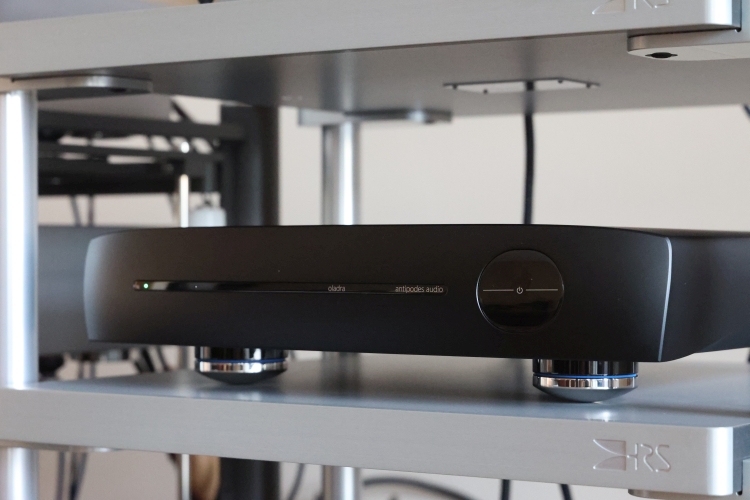
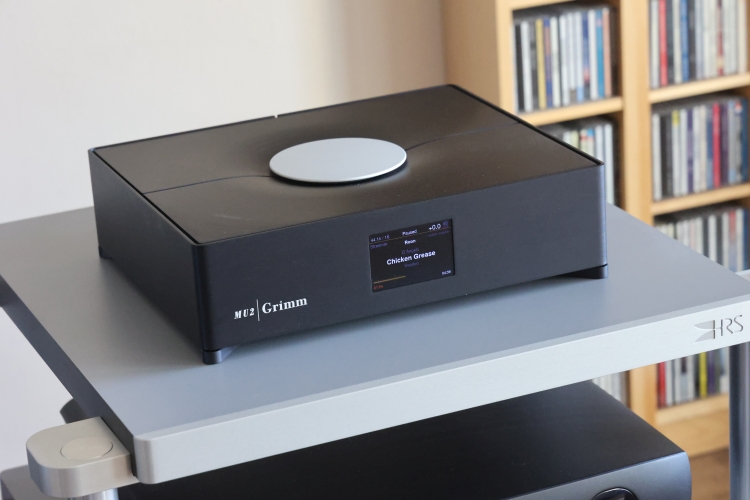
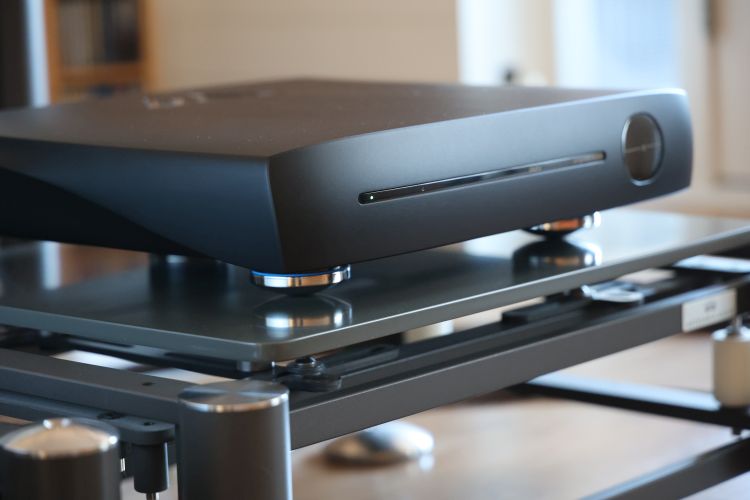
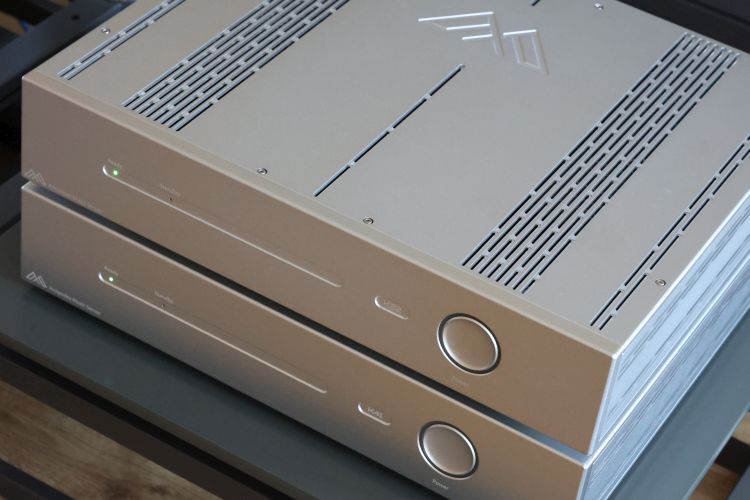
Christiaan, I am reading some interesting things about the 432 EVO MASTER server. It is said to be one of the best sounding servers on the market, would you be able to get one in for a review? I would like to know how it compares to the Pink Faun 2.16X
Hi Paul, actually, I was approached by Frederic vanden Poel during the XSFi show a few weeks ago about reviewing his latest server. So, that may well happen:-)
That would be great. I’d love to know how the Taiko Audio Extreme compares as well, especially to the 2.16x. I’m looking for a quality server, just wondering if I need to save a little more!
Haha yes, I understand. Although there are currently no plans for testing this server it’s still on the TO DO list.
Very impressive review.
I have a Aqua la scala mk2 dac and a SOtM sms200ultra using it as roon endpoint. I’m mainly interested in the upcoming PF Scion but this review was very useful, both because I guess the Scion will have a similar sound signature as the 2.16x and because of the comparisons of usb and i2s.
Thanks,
Rick
Hi Christiaan,
thia is another excellent review, highlighting all aspects of audiophile servers.
To further explore the top league of servers you should review the following:
Taiko Audio SGM Extreme
and
Innuos Zenith Statement
Thank you
Matthias
Hi Christiaan
Nice review. Are you planning in the near future to review the Grimm MU1?
Iam in the race to buy a new streamer for my Mola-Mola Tambaqui dac, the question is what to buy.
Martin
Hi Martin, I may well indeed but have no plans as of yet. However, I understand from a colleague reviewer whose opinion I trust that the MU1 with Tambaqui is one of the best server/DAC combo’s he’s heard.
Hi Christiaan, I am very keen to find out what your opinion is of the above. Shame that these boards are all additional upgrades that come with additional expense. I have upgraded to the HD board on my C1 at least so now twiddling my thumbs waiting for another splendid review lol ; )
Hi Paul, the review of the Roon Ethernet card has been out for a while. As outlined there in detail, with the Antipodes CX, I do indeed now prefer Ethernet over USB. For the easiest way to be notified of HFA updates, please check the HFA Facebook page where I post all articles that are coming up as well as when they have been published. PS: I agree that the cards are not inexpensive but at the quality level of the C1, I’m afraid that nothing is… in any event, all the CH updates so far have proven to be absolutely worth the expense.
Hi Christian, good review, I’ve been thinking of either getting a Pink Faun 2.16X or something from Taiko Audio who make the SGM gear, I’m very close to getting an Aqua XHD Dac but I also have a Tidal Preos D as well and wondered if it would be worthwhile getting the IS2 board for play through the Aqua XHD and then RCA Connection to the Preos and the Spdif board for going straight to the Preos, would be interested in your thoughts ?
Hi Shane, without exception, I2S has always sounded best to me. I’ve not heard the Tidal or the Taiko Audio/SGM and so can’t comment on this. I do think that the Pink Faun and the Taiko may well be the two best servers in the world. I would advise to listen to them both. If it helps, I always like having options because circumstances can and often will, change, so preparing both coaxial out and I2S is always handy. FYI Aqua has recently issued a V2 output board that adds some more “presence” and “dynamics” to the sound of the xHD, very worthwhile.
Hi Christian, yes I just ordered the Aqua on Wednesday so it’s coming straight from them and should be updated to the latest spec. Do you think getting the Ultra Clocks make a difference to just the normal clocks that can be fitted. For the added price I think it would be a no brainier not to get the Ultra Clocks to boost the performance.
Hi Shane, the ultra clock definitely made a very noticeable difference, making the sound more organic and refined and more natural, less measured, which is interesting as the precision should have actually gone up. That’s the wonderful world of high-end audio, I’m afraid:-)
Hello Christian,
I was wondering if you had heard the 432 EVO Master server and the APL DNP streamer. If so, how would you compare them to the Pink Faun 2.16x streamer ?
Hi Sylvain, Alas, I have not heard the latest 432 server nor the APL but having hear the original 432 EVO I know that it has a very different presentation than the Pink Faun. The former is most notable for its smooth, relaxed and organic 3D sound while the latter is all about transparency, articulation and transient speed. That’s not to say that the 432 lacks detail or the PF cannot sound organic but assuming that the 432 has not changed, basically, the decision is between more relaxed and more articulate.
Hi Christian, thanks a lot for this review and for sharing your inner debates!
As the first comment on this page, I am interested in the comparison with the PF and the CX/EX combo. Clearly the issue we all have is that it is impossible to compare them into our own system the way you did it.
I do have Wilson Audio’s speakers as well and two DACs with tube based outputs, one DAC connected over SPDIF or AES (I switch depending on the type of music – I share your observation) which deals with PCM only, and another one which has its own high quality streamer embedded so connected over ethernet. The latter is more recent, of course, but I could not completely abandon the organic sound of the former on voices. My pream and amp are solid state, very dynamic and great with transient, but still with very analog sounding on the Wilson Audios.
Three questions for you:
1) did you make any comparison using ethernet connections and consequently an external streamer (guess that the EX in this case is useless, so more the CX vs the PF connected over ethernet)?
2) it reads like you had to play a lot with the PF and the connections for getting an organic, non-excessively transparent and forward sound through the Wilson Audios. Should one be worried? For instance, I can’t stand to listen to them with the traditional dCS electronics, and with most of solid state pre-/amplifiers.
3) any thought on how PF compares with the InnuOS statement?
Thanks!
Hi Fabien,
Alas – I’ve not heard any of the Innuos servers.
When the PF was here I did not use it as a streaming endpoint and neither did I compare it to the EX or CX as a streaming endpoint. However, I did change to using the Antipodes CX as a server streaming directly to the C1 using its RoonReady Ethernet card. You can read about this and how it compares to USB in the CH Precision Ethernet_IN HD board Upgrade review.
With the Wilsons and using USB, I found the PF to be too clean for my taste and that’s why I preferred the arguably more organic Antipodes combo even if the PF operates on a higher audiophile level. When using the SPDIF board, however, the PF was really great. But its inherently very high precision means that the pairing with very expressive, at times slightly edgy and intrinsically “trigger-happy” speakers such as the Wilsons could result in an overly-controlled sound. In that case, some mellowing elsewhere in the system may be desirable and this could be done with the server choice (which also downgrades the resolution) or perhaps by using smooth cables.
With the Logans or Kromas, or other smoother sounding speakers, this may be entirely different.
I have a question on the ultra clock for the SPDIF bridge. What does it do in terms of warmth, density, thickness and “bloom”? Is the sound warmer as well (on top of being more natural and organic)?
It’s been a while but off the top of my head maybe the SPDIF bridge output is slightly warmer than USB (in the sense that it has more bloom) but then only very slightly. Mostly, it injects more flow and a more organic quality. I don’t feel that it clogs up or thickens the sound in any way.
great review! … and yet, hand on heart – in 2025 – what do you like more as a technology (in terms of sound quality) – CD transports or computer servers?
It depends on what one wants. I personally want the cleanest, purest, most uneditorialized sound, without it becoming clinical or devoid of life, emotion, and lyrical qualities. To achieve this with a music server is, perhaps unexpectedly, much harder than with a good CD transport. However, I much prefer the comfort of having a library at my finger tips, creating playlists, making quick and easy AB comparisons, etc. If you want stereotypical “analog” warmth, smoothness, and fluidity, well, servers can also do that very well these days. However, many such servers also reduce PRaT, transient attack, or the expression and liveliness in the process. Playback software also has a say in this.
To answer your question literally: as a technology, I prefer music servers and streaming. But I continue to be amazed that it is so much easier to obtain superb sound from a good CD transport, and so easy for a server or music playback software, to dilute the result.